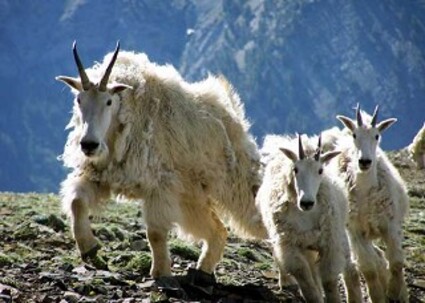Of mountain goats and unicorns
Last updated 8/9/2016 at Noon

courtesy ODFW
Mountain goat mom and kids in the high country of Oregon, thanks to the restoration efforts of ODFW.
Peter Eshrick of Camp Sherman was making his annual pilgrimage hike into the saddle above Canyon Creek Meadows on Wednesday, July 20, with his daughter Katrina and her two kids, Camila and Samuel (ages 12 and 10), when Camila suddenly shouted, "What's that over there on the mountainside?"
"What, over where?" Peter replied.
Camila pointed to the talus slopes on the side of Three Fingered Jack, above the ice lake and said, "Those white dots over there. They're moving; they look like polar bears, or maybe they're unicorns."
"Well," said Peter, recalling the tale, "Camila's sharp young eyes may have been able to spot them easily, but it took a lot of pointing and describing before I finally saw what she was pointing at.
"By then Katrina and Samuel had reached the top, and of course both of them spotted what we were talking about straight away. Soon the debate was raging: Bighorn sheep? Mountain goat? Polar bear? Unicorn? There was a strong contingent going for polar bear, with unicorn having at least one vocal proponent."
When Peter passed this story on to The Nugget, there was only one who could answer the questions that developed from the sighting: Oregon Department of Forestry Wildlife Biologist Corey Heath in the Bend Regional Office.
After a discussion with Heath about the possibility of a unicorn or polar bear on Three Fingered Jack, Heath said, "We're too far south for a polar bear, and don't ask me about unicorns, I know nothing about them."
Then, with a broad grin, he added, "But if you want to talk about mountain goats, I'm your man."
According to Heath, the first attempt to reintroduce mountain goats (aka Rocky Mountain goats) to Oregon was a small release back in the early 1950s, into the Wallowas of Eastern Oregon. (Biologically speaking, mountain goats are not true goats, but they are close relatives-more properly known as "goat-antelopes.)
Up to the early 1980s things were sort of in limbo. Then a release was made into the Elkhorns and the Mt. Adams areas in 1983, and a couple of years later a small group of mountain goats was spotted in the Strawberries, near John Day (most thought they had made it from the Elkhorns).
Then in March of 2010 a lone billy appeared at Horse Ridge, 20 miles east of Bend, in Dry Canyon. It was hard to miss, that beautiful white coat set against the dark basalt lava rock cliffs on Dry Canyon.
He was captured and a radio collar was placed on him, and he was released. Wildlife biologists are of the opinion that he wandered cross-country all the way from the release in the Elkhorns way over by Sumpter.
After being radio-tagged, he eventually meandered over into the Mt. Newberry area where he met up with a sweet little radio-collared nannie - placed there by Heath and members of the ODFW mountain goat crew - who eventually gave birth to a kid. the fate of the kid is unknown, as the nannie was found dead last spring.
In 2013, combined efforts of the Confederated Tribes of Warm Springs and ODFW biologists trapped 24 mountain goats from the Elkhorns group and released them in tribal lands on the lower slopes of Mt. Jefferson.
Historical literature and archeological evidence tells today's biologists that Rocky Mountain goats occurred on Mt. Jefferson prior to the appearance of European Americans, and the region still appears to be a good fit for the species. ODFW last surveyed the area in mid-July, and counted 29 goats during the aerial survey, including two sets of twins.
Brady Wessel of Sisters emailed to say he spotted a mountain goat nannie feeding on grasses on the side of Forest Road 2076, near Link Lake. Heath thinks this could be one of the goats from the group the Eshrick family spotted on Three Fingered Jack.
Wessel said, "I was driving back from Link Lake, when I saw a white animal emerge from the bushes on the left of the road. I was a bit shocked when I realized it was a goat! It had small, pointy horns and hooves, and looked a little scruffy, perhaps from shedding its winter coat. It ran up the road when it saw me and veered off to the right, going back up into the bushes."
Those who sight a mountain goat should give them lots of room. Don't chase it, or follow it. Just stop and let the animal (any wild animal) leave your presence in its own time and space.
















Reader Comments(0)